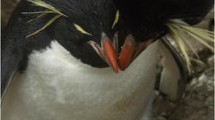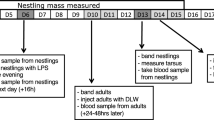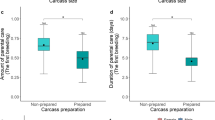Abstract
Recent studies suggest that parental resource allocation may be the most important factor explaining differences in reproductive output among parents. That said at least two different hypotheses of balance between parental foraging effort and resource allocation have been proposed. First, parents with high foraging effort have high reproductive success. Second, parents with higher allocation of resources to offspring have high reproductive success. We tested the second hypothesis using chinstrap penguins (Pygoscelis antarctica) as a model. We evaluated nutritional condition of the parents using blood urea, uric acid, creatine kinase, and cholesterol levels. We evaluated reproductive success according to total mass of the brood and asymmetries inside the brood. We measured the degree of asymmetry using weight and culmen length. Generalized linear models were used to examine relationships between adult plasma urea levels with year, nest position, and degree of asymmetry in chicks. Our results demonstrate that lighter broods were more asymmetric and associated with lower values of adult plasma urea, uric acid, and creatine kinase. We interpret these findings as evidence that the birds allocate fewer resources to their chicks than adults with more symmetric broods are.



Similar content being viewed by others
References
Ainley DG, Schlatter RP (1972) Chick raising ability in Adélie penguins. Auk 89:559–566
Alonso-Alvarez C, Ferrer M (2001) A biochemical study of fasting, subfeeding, and recovery processes in yellow-legged gulls. Physiol Biochem Zool 74:703–713
Alonso-Alvarez C, Ferrer M, Velando M (2002) The plasmatic index of body condition in Yellow-legged Gulls Larus cachinnans: a food controlled experiment. Ibis 144:147–149
Alonso-Alvarez C, Ferrer M, Viñuela J, Amat JA (2003) Plasma chemistry of chinstrap penguin Pygoscelis antarctica during fasting periods: a case of poor adaptation to food deprivation? Polar Biol 26:14–19
Amat JA, Viñuela J, Ferrer M (1993) Sexing chinstrap penguins (Pygoscelis antarctica) by morphological measurements. Colon Waterbird 16:213–215
Balbontin J, Ferrer M (2005) Condition of large brood in Bonelli’s Eagle Hieraaetus fasciatus. Bird Study 52:37–41
Ballard G, Dugger KM, Nur N, Ainley DG (2010) Foraging strategies of Adélie penguins: adjusting body condition to cope with environmental variability. Mar Ecol Prog Ser 405:287–302
Barbosa A, Moreno J, Potti J, Merino S (1997) Breeding group size, nest position and breeding success in the chinstrap penguin. Polar Biol 18:410–414
Boersma PD (1976) An ecological and behavioral study of the Galápagos penguin. Living Bird 15:43–93
Boersma PD (1991) Asynchronous hatching and food allocation in the Magellanic Penguin Spheniscus magellanicus. Acta XX Congressus Internationalis Ornithologici, pp 961–973
Boggs CL (1992) Resource allocation: exploring connections between foraging and life history. Func Ecol 6:508–518
Bryant DM (1987) Energy expenditure and body mass changes as measures of reproductive costs in birds. Func Ecol 2:23–34
Casado E, Balbontin J, Ferrer M (2002) Plasma chemistry in Booted Eagles (Hieraaetus pennatus) during breeding season. Comp Biochem Physiol 131:233–241
Chappell MA, Janes DN, Shoemaker VH, Bucher TL, Maloney SK (1993) Reproductive effort in Adélie penguins. Behav Ecol Sociobiol 33:173–182
Cherel Y, Robin JP, Le Maho Y (1988a) Physiology and biochemistry of long-term fasting in birds. Can J Zool 66:159–166
Cherel Y, Robin JP, Le Maho Y (1988b) Fasting in king penguin. I. Hormonal and metabolic changes during breeding. Am J Physiol 254:170–177
Cherel Y, Robin JP, Le Maho Y (1988c) Fasting in king penguin. II. Hormonal and metabolic changes during molt. Am J Physiol 254:178–184
Cherel Y, Fréby F, Pilles J, Robin J-P (1993) Comparative fuel metabolism in gentoo and king penguins: adaptation to brief versus prolonged. Polar Biol 13:263–269
Cooper J (1977) Energetic requirements for growth of the jackass penguin. Zool Afr 12:201–213
Coulson JC, Monaghan P, Butterfield J, Duncan N, Thomas C, Shedden C (1983) Seasonal changes in the Herring gull in Britain: weight, moult and mortality. Ardea 71:235–244
Croxall JP, Rothery P (1991) Population regulation of seabirds: implications of their demography for conservation. In: Perrins CJ, Lebreton JD, Hirons GJM (eds) Bird population studies: relevance to conservation and management. Oxford University Press, Oxford, pp 272–296
De León A (2000) Estrategias reproductoras en el pingüino barbijo (Pygoscelis Antarctica). Universidad Complutense de Madrid, Madrid
De León A, Soave G, Ferretti V, Moreno J (2001) Factors that affect hatching asynchrony in the Chinstrap penguin (Pygoscelis antarctica). Polar Biol 24:338–342
Fargallo JA, Polo V, de Neve L, Martin J, Davila JA, Soler M (2006) Hatching order and size-dependent mortality in relation to brood sex ratio composition in chinstrap penguins. Behav Ecol 17:772–778
Ferrer M (1990) Hematological studies in birds. Condor 92:1085–1087
Ferrer M (1992) Regulation of the period of postfledging dependence in the Spanish Imperial Eagle Aquila adalberti. Ibis 134:128–133
Ferrer M (1993) Ontogeny of dispersal distances in young Spanish imperial eagles. Behav Ecol Sociobiol 32:259–263
Ferrer M (1994) Nutritional condition of Spanish Imperial Eagle nestlings Aquila adalberti. Bird Study 41:120–123
Ferrer M, Dobado-Berrios P (1998) Factors affecting plasma chemistry values of the Spanish imperial Eagle, Aquila adalberti. Comp Biochem Physiol 120:209–217
Ferrer M, García-Rodríguez T, Carrillo JC, Castroviejo J (1987) Hematocrit and blood chemistry values in captive raptors (Gyps fulvus, Buteo buteo, Milvus migrans, Aquila heliaca). Comp Biochem Physiol 87:1123–1127
Ferrer M, Amat JA, Viñuela J (1994) Daily variations of blood chemistry values in the chinstrap penguin (Pygoscelis antarctica) during the Antarctic summer. Comp Biochem Physiol 107A:81–84
García-Rodríguez T, Ferrer M, Carrillo JC, Castroviejo J (1987) Metabolic responses of Buteo buteo to long-term fasting and refeeding. Comp Biochem Physiol 87:381–386
Gustafsson L, Sutherland WJ (1988) The costs of reproduction in the Collared Flycatcher Ficedula albicollis. Nature 335:813–815
Harshman LG, Zera AJ (2007) The cost of reproduction: the devil in the details. TREE 22:80–86
Hillström L (1995) Body mass reduction during reproduction in the Pied Flycatcher Ficedula hypoleuca: physiological stress or adaptation for lowered costs of locomotion? Func Ecol 9:807–817
Lack D (1968) Ecological adaptations for breeding in birds. Methuen, London
Lescroël A, Ballard G, Toniolo V, Barton KJ, Wilson PR, Lyver PO, Ainley DG (2010) Working less to gain more: when breeding quality relates to foraging efficiency. Ecology 91:2044–2055
Lima S (1986) Predation risk and unpredictable feeding conditions: determinants of body mass in birds. Ecology 67:377–385
Minguez E, Belliure J, Ferrer M (2001) Bill size in relation to position in the colony in the chinstrap Penguin. Waterbirds 24:34–38
Moreno J (2003) Lifetime reproductive success in seabirds: interindividual differences and implications for conservation. Sci Mar 67:7–12
Moreno J, Carrascal LM, Sanz JJ, Amat JA, Cuervo JJ (1994) Hatching synchrony, sibling hierarchies and brood reduction in the chinstrap penguin Pygoscelis antarctica. Polar Biol 14:21–30
Moreno J, Barbosa A, Potti J, Merino S (1997) The effects of hatching date and parental quality on chick growth and creching age in the chinstrap penguin (Pygoscelis antarctica): a field experiment. Auk 114:47–54
Moreno J, Viñuela J, Belliure J, Ferrer M (1998) Effect of brood size on growth in the chinstrap penguin: a field experiment. J Field Orn 69:269–275
Moreno J, Barbosa A, De León A, Fargallo JA (1999) Phenotypic selection on morphology at independence in the chinstrap penguin Pygoscelis antarctica. J Evol Biol 12:507–513
Noordwijk AJ, de Jong G (1986) Acquisition and allocation of resources: their influence on variation in life history tactics. Am Nat 128:137–142
Norberg RA (1981) Temporary weight decrease in breeding birds may result in more fledged young. Am Nat 118:838–850
Nur N (1984) The consequences of brood size for breeding Blue Tits. Adult survival, weight change and the cost of reproduction. J Anim Ecol 53:479–496
Pugesek BH (1995) Offspring growth in the California gull: reproductive effort and parental experience hypotheses. Anim Behav 49:641–647
Røskaft E (1985) The effect of enlarged brood size on future reproductive potential on the Rook. J Anim Ecol 54:255–260
Seddon PJ, Van Heezik YM (1991) Hatching asynchrony and brood reduction in the jackass penguin: an experimental study. Anim Behav 42:347–356
Stat Soft Inc (2004) Statistica 7.0. Tulsa, OK, USA
Stearns SC (1976) Life-history tactics: a review of ideas. Quart Rev Biol 51:3–47
Takahashi A, Watanuki Y, Sato K, Kato A, Arai N, Nishikawa J, Naito Y (2003) Parental foraging effort and offspring growth in Adélie penguins: does working hard improve reproductive success? Funct Ecol 17:590–597
Taylor JRE (1985) Ontogeny of thermoregulation and energy metabolism in pygoscelid penguin chicks. J Comp Physiol 155:615–627
Taylor RH, Roberts HS (1962) Growth of Adélie penguin (Pygoscells adeliae Hombron and Jacquinot) chicks. N Z J Sci 5:191–197
Tinbergen JM (1987) Costs of reproduction in the Great Tit: intraseasonal costs associated with brood size. Ardea 75:111–122
Trivelpiece WZ, Trivelpiece SG, Volkman NJ (1987) Ecological segregation of Adelie, gentoo, and chinstrap penguins at King George Island, Antarctica. Ecology 68:351–361
Viñuela J (1997) Adaptation vs. constraint: intraclutch egg-mass variation in birds. J Anim Ecol 66:781–792
Viñuela J (1999) Sibling aggression, hatching asynchrony, and nestling mortality in the black kite (Milvus migrans). Behav Ecol Sociobiol 45:33–45
Viñuela J, Moreno J, Carrascal LM, Sanz JJ, Ferrer M, Amat JA, Belliure J, Cuervo JJ (1996) The effect of hatching date on parental care, chick growth and chick mortality in the chinstrap penguin Pygoscelis antarctica. J Zool Lond 240:51–58
Weimerskirch H (1999) The role of body condition on breeding and foraging decisions in albatrosses and petrels. In: Adams NJ, Slotow RH (eds) Proceedings of 22 international ornithological congress. Durban, Johannesburg, pp 1178–1189
Wendeln H, Becker PH (1999) Effects of parental quality and effort on the reproduction of common terns. J Anim Ecol 68:205–214
Williams AJ (1980) Aspects of the breeding biology of the gentoo penguin, Pygoscelis papua. Gérfaut 70:283–295
Williams TD, Croxall JP (1991) Chick growth and survival in gentoo penguins (Pygoscelis papua): effect of hatching asynchrony and variation in food supply. Polar Biol 11:197–202
Wooller RD, Bradley JS, Croxall JP (1992) Long-term population studies of seabirds. TREE 7:111–114
Ydenberg RC (1994) The behavioral ecology of provisioning in birds. Ecoscience 1:1–14
Acknowledgments
The present study was supported by grant ANT91-1264 from the Spanish C.I.C.Y.T. (Plan Nacional Antártico). We gratefully acknowledge the Spanish Navy vessel ‘‘Hesperides’’ for transport to and from Deception Island, the Spanish Army Base ‘‘Gabriel de Castilla’’ and the personnel at Argentine Base for their hospitality and logistic support. Three anonymous referees greatly improved early drafts of this paper. We are indebted to Keith Bildstein for correction of the English text.
Author information
Authors and Affiliations
Corresponding author
Rights and permissions
About this article
Cite this article
Ferrer, M., Belliure, J., Viñuela, J. et al. Parental physiological condition and reproductive success in chinstrap penguins (Pygoscelis antarctica). Polar Biol 36, 529–535 (2013). https://doi.org/10.1007/s00300-012-1279-z
Received:
Revised:
Accepted:
Published:
Issue Date:
DOI: https://doi.org/10.1007/s00300-012-1279-z




